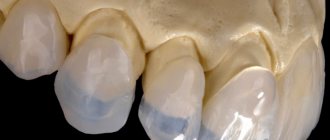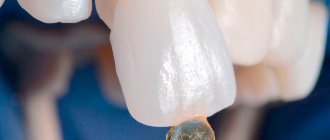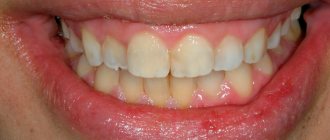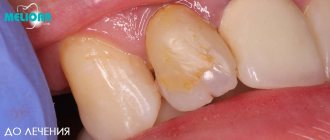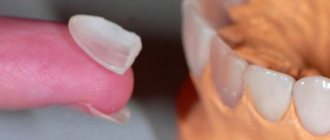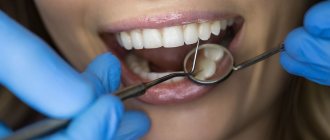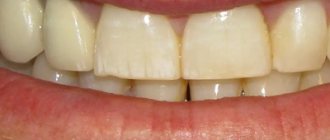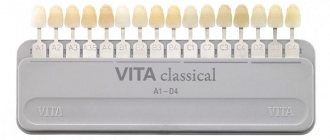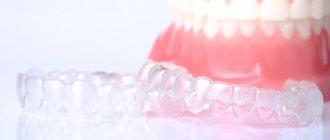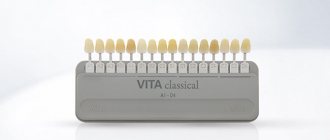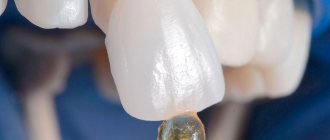A beautiful “Hollywood” smile is the dream of many people. But not many, including Hollywood actors, can boast of it naturally.
To hide imperfections in the front teeth and create a beautiful smile, people are increasingly turning to aesthetic dentistry for help.
Installing veneers is one of the best ways to make your smile perfect today.
Veneers are thin translucent microprosthetic plates that are placed on the front of the teeth to hide visible defects.
Until recently, there were only a few models of dental onlays. And they differed only in material and price. The development of modern technologies has made it possible to bring this field of microprosthetics to a new level, which has expanded the number of ways to restore the attractiveness of a smile.
Veneers
Veneers
Veneers are a common name for onlays that are made from various materials and are installed on the front teeth to visually improve their appearance and prevent early decay.
At one time, they became an advanced method in improving the visual appearance of teeth and an alternative to installing massive crowns or implantation.
Depending on the material from which they are made, there are the following veneers:
- composite;
- ceramic (or porcelain);
- zirconium.
What is their difference?
Composite veneers
They were one of the first to appear on the aesthetic dentistry market. They are mainly made from filling materials and are not much inferior in quality to other linings.
Composite veneers
There are a number of benefits from using these veneers:
- no complete grinding of teeth is required;
- are established in one visit to the doctor;
- It is easier for a composite veneer to choose a natural color and texture that will not differ from other teeth;
- such onlays are installed on one or two teeth for minor defects;
- if you increase the number of layers of composite material, you can achieve higher strength;
- if necessary, these veneers can be easily removed by a dentist;
- relatively low cost.
However, despite the advantages of using such veneers, there are also significant disadvantages:
- Over time, the color of the veneers may change;
- in order to keep the linings in their original form longer, the patient will have to stop eating certain types of products;
- There are not so many shades of the composite, so there is still a possibility that the color of the teeth will be slightly different;
- the quality of manufacturing and installation of composite onlays depends on the professionalism of the dentist and his experience, so there is a risk of getting a poor-quality result;
- the large thickness of the plate itself is about 1 mm, which creates an unnatural appearance when speaking;
- due to the fact that the material does not adhere exactly to the surface of the tooth, there is a possibility of plaque accumulation, and this is fraught with the occurrence of caries and gum inflammation.
- Service life up to 7 years with proper care.
Since the service life of composite veneers is short and the number of disadvantages is large, more and more clinics are abandoning their installations in favor of more modern materials.
Ceramic veneers
Ceramic veneers
The main difference between ceramic veneers and composite ones is that they are made in laboratories after appropriate impressions of the teeth and a panoramic photograph of the jaw have been taken. Therefore, to install them, you must visit your doctor at least twice.
Among the main advantages of ceramics are:
- aesthetic qualities - the color of the overlays is as close as possible to the natural color of tooth enamel;
- high degree of resistance to coloring products;
- durability and long period of use - service life declared by experts is 10 years;
- There is no need for any special care - it is enough to perform basic oral hygiene and visit the dentist once a year for preventive maintenance.
The disadvantage of ceramic veneers is their high price compared to composite ones, which can seriously hit clients’ wallets.
Zirconium veneers
Marielaina Perrone DDS Porcelain Crowns
The basis for the manufacture of such onlays is zirconium dioxide, which is considered advanced in the aesthetic dentistry market. In the manufacture of the zirconium dioxide frame, on which the ceramic material is applied, expensive Western computer technology CAD/CAM is used.
Recently, in addition to crowns and dentures, this material has also been used to make onlays, which have the following advantages:
- super durable material;
- color stability;
- the ability to choose an individual shade according to the Vita scale;
- the minimum thickness of the lining is from 0.3 mm, which makes them almost invisible;
- biocompatibility with teeth, absence of allergic reactions;
- service life - up to 20 years.
However, despite the significant advantages, there are also disadvantages to such veneers:
- high cost - comparable to installing implants;
- the clinic must have special equipment on which veneers are made;
- The doctor must have the necessary qualifications to work with zirconia veneers.
Recommended for:
The second name for veneers is overlay plates. They are a thin layer of modern materials that can be used to solve minor dental defects. The method compares favorably with similar ones in that it requires much less time and does not involve the use of aggressive chemical solutions that can cause reactions in allergy sufferers.
Indications for installation of veneers are as follows:
- the presence of chips and deformations on the enamel surface;
- minor anomalies in tooth shape;
- the need to remove stains on the enamel or the impossibility of teeth whitening using classical methods using reagents;
- change in color of fillings;
- curvature of the frontal surface of the dentition;
- hiding large interdental spaces.
Veneers only solve minor problems. For example, if dentin destruction affects a large area, this method will not be suitable, since the thickness of the onlay plate should not exceed 0.7 mm.
Lumineers
Lumineers
A new direction in aesthetic dentistry has recently been the installation of lumineers . They are also called Hollywood teeth veneers. American manufactures and supplies such linings.
The plates are made from high-strength ceramics, the plate thickness of which is only 0.2-0.3 mm.
Installing lumineers, unlike ceramic veneers, has a number of positive aspects:
- before installing ultra-thin veneers, no heavy grinding of the tooth is required; only a minimal layer of enamel is removed;
- since the installation procedure does not require tooth preparation, therefore, it is painless and does not require anesthesia;
- resistance to mechanical loads, do not wear out over time;
- these linings are glued to a special composition insoluble in saliva, which contains a substance - fluoride, which has a beneficial effect on the teeth, and thereby protects against secondary caries;
- the ability to choose the color of the lining identical to the natural color of the patient’s teeth;
- The service life of such veneers is up to 20 years.
Despite the advantages of lumineers, there are also disadvantages:
- since lumineers are produced only in one place - in America, patients have to wait about 2 months before installation;
- The cost of installing one lumineer is several times higher than the cost of a veneer.
How to do it
Installation takes place in several stages. Before starting, an examination of the oral cavity is carried out, and all diseases of the teeth and gums are eliminated. In some cases, new fillings are installed if the old ones have already exhausted their service life and need to be replaced.
When everything is back to normal, the dentist removes the top layer of enamel. The more experienced the dentist, the thinner the layer removed will be. At the same time, deposits and cracks are eliminated. Then direct installation is possible (when the onlays are installed at one time) or indirect (when an impression is made, it is sent for the production of veneers, the patient is given temporary onlays for this period, and after a couple of weeks the permanent ones are attached). To fix veneers on teeth, adhesive cement solutions used in dentistry are used.
Ultraneers
Ultraneers
They appeared relatively recently and serve as a good alternative to American lumineers. This type of onlay was developed in Russia based on patented ceramics of the IPS E. MAX brand.
Using modern technologies, pressed ceramics are produced from which ultra-thin plates are created - ultraneers.
Pros of ultra training:
- high aesthetics - the color of the lining can be matched exactly to the natural shade of the patient’s teeth;
- It can also be installed on sensitive teeth, since the grinding of the supporting tooth is minimal or not done at all;
- strength is 40% higher than that of ceramic veneers;
- since this is a completely Russian development, the cost does not depend on currency fluctuations and is therefore lower than the cost of lumineers;
- no need to wait several months before installation, since the product is manufactured in Russia;
- service life is about 15 years.
A significant disadvantage of ultranir is their high cost. They are 2 times more expensive than veneers, although they are produced in Russia. However, the cost of ultraneers is 30-40% lower than the cost of American lumineers.
Is it possible to remove
Installing a veneer overlay is quite simple. But there are times when you have to remove it:
- Wear. Veneers made from cheap materials may darken or change color prematurely.
- Damage. Sometimes even the highest quality material develops defects due to injury. In rare cases, the overlay peels off severely, after which discomfort occurs, since the enamel of the front surface was processed and thinned during installation.
- Deep caries. If the carious cavity that appeared during the use of veneers has a large area, the veneers must be removed before treatment.
- Poor installation. In rare cases, an incorrectly sized veneer may be installed and will have to be replaced.
Nanoneers
Nanoneers
There is a misconception that nanoeers are a new generation of American lumineers. This is not entirely true.
This veneer design is created in Russian clinics, but from material and technology developed in Switzerland. The ceramics used to make nanoirs contain nanoparticles, which significantly improves the quality of the material.
The similarity with lumineers is that the abutment tooth is not ground down before installation. However, after the onlay is fixed, it must be polished and adjusted to the size of the tooth.
The advantage of this type of overlay is that they are cheaper than ultraneers and lumineers. But at the same time they are not so durable and aesthetically pleasing. In Russia, such prostheses are installed only in some clinics.
Is it always possible to get veneers?
Installation of veneers and lumineers is carried out only on healthy teeth. Therefore, before installing any type of onlays, the patient needs to visit the dentist’s office and undergo a full examination of the oral cavity - to cure caries and get rid of possible problems with the gums. This is necessary so that in the future, when installing veneers, no problems arise, and they do not have to be removed ahead of time.
It must be remembered that, like any medical procedure, the installation of veneers has contraindications:
- the presence of a pronounced malocclusion, which must first be corrected with braces or any other removable denture;
- bruxism - involuntary “grinding” of teeth, which can destroy even a durable denture;
- the absence of more than 50% of the tooth or the presence of a large filling on the surface of the tooth, which will make it difficult to securely fix the onlay on the tooth;
- lack of chewing teeth;
- pathological abrasion of teeth;
- periodontal disease.
As you can see, many contraindications are relative - they, one way or another, can be eliminated by the dentist, after which veneers can be installed.
To avoid any unpleasant moments in connection with the installation of veneers and to make your smile shine again and bring you joy, you need to contact only professionals.
What are implants: features of treatment protocols
So, if you have no teeth at all, veneers are not suitable. Alternative options are removable dentures or implants. Implantation is beneficial for many indications, especially when the patient is completely edentulous.
An implant in dentistry is a multicomponent structure that includes:
- A pin is an implant itself that is implanted into the patient’s bone tissue and acts as a “root” for an artificial tooth. The pin is made from pure medical titanium or a titanium alloy that can integrate into the bone and become part of the bone structure of the jaw.
- An abutment is an adapter responsible for attaching the crown to the titanium pin of the implant. Has different sizes and shapes. Selected by the dentist for a specific type of implant.
- An artificial tooth is a crown made of metal ceramics or zirconium dioxide that can replace a tooth not only externally, but also take over its chewing functions.
When veneers are not possible due to a patient missing one or more units, implants are an excellent choice. Their main advantage is the ability to withstand loads similar to living teeth and create the necessary physiological pressure on bone tissue.
For complete edentia, all-on-4 and all-on-6 implantation protocols are indicated, in which a fixed prosthesis is placed on 4 or 6 implants immediately after the implantation of the pins. The prosthesis completely duplicates the patient's jaw being replaced. This type of implantation is also called one-stage implantation.
